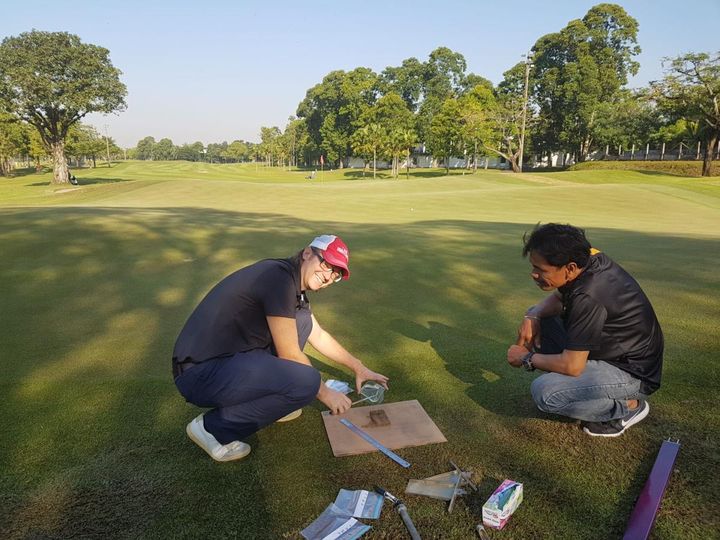That's not the way it is supposed to work
 Collecting soil samples from seashore paspalum greens in Bangkok, Thailand.
Collecting soil samples from seashore paspalum greens in Bangkok, Thailand.Of the many interesting things in the report by Gelernter et al. on the GCSAA’s second nutrient use survey, I was especially intrigued by the part about soil testing.
First, a little background. If one has no idea how much of any mineral element is in the soil, then the logical amount to apply as fertilizer is just a little bit more than the grass can use. This guarantees that the grass will be supplied with all of each element that it can use. That’s like an estimate of the maximum amount of fertilizer to apply.
Why soil test? Because soil testing allows for more efficient application of fertilizer. After finding out how much is in the soil, one can often reduce the quantity of fertilizer applied, because one knows that the soil can supply some portion of the plant’s requirements.
With no soil testing, it makes sense to apply all that the grass could use. With soil testing, it makes sense to apply only the amount that the grass could use that can’t be supplied by the soil. It’s evident that the maximum amount of fertilizer should be applied when one doesn’t know the nutrient content of the soil, and that in the most infertile soils, the quantity of nutrients required as fertilizer will be close to the maximum, with the quantity required as fertilizer decreasing as soon as the soils have some quantity of nutrients.
In the last chapter of A Short Grammar of Greenkeeping, I wrote that “I’d recommend soil testing, because in most soils the correct interpretation of soil tests can reduce the quantity of fertilizer that is applied.”
You may have heard me say that soil testing is broken. For more background:
- Conventional nutrient guidelines: explaining what I mean by broken
- Why is the grass so good, but the soil test results so bad?
Now back to the GCSAA nutrient use survey results. Here’s what the survey says:
Despite the fact that respondents said that they used soil tests to reduce reliance on fertilizers, higher use rates were observed for respondents who conducted soil tests (Table 7). This apparent contradiction may be due to some of the turf fertility guidelines currently in use, which target higher nutrient levels than are required for acceptable turf growth.
As a result, those who conduct soil tests with the belief that it will help them to reduce fertilizer inputs may end up unintentionally increasing fertilizer instead, likely because the guidelines used to evaluate their results may be higher than necessary.
That’s not the way it is supposed to work.